
USER MODELING AND USER-ADAPTED INTERACTION
Scope & Guideline
Transforming Education Through User-Adaptive Insights
Introduction
Aims and Scopes
- User Modeling Techniques:
The journal explores various user modeling techniques, including data-driven approaches, machine learning, and psychological modeling, to understand user preferences, behaviors, and needs. - Adaptive Systems:
Research on adaptive systems that respond to user context, preferences, and interactions is central. This includes adaptive user interfaces, recommender systems, and personalized learning environments. - Human-Robot Interaction:
The journal highlights studies on human-robot interaction, focusing on how personalization and user feedback can enhance communication and cooperation between humans and robots. - Conversational Interfaces:
A significant focus is on conversational recommender systems, investigating how dialogue and interaction can be tailored to improve user engagement and satisfaction. - Evaluation and User Experience:
The journal emphasizes the importance of evaluating user experience and the effectiveness of adaptive systems, often employing empirical studies to assess user satisfaction and engagement.
Trending and Emerging
- Neuro-Symbolic Approaches:
Emerging research is focusing on neuro-symbolic methods in recommender systems, combining neural networks with symbolic reasoning to enhance knowledge representation and user understanding. - Emotion-Adaptive Systems:
There is a growing trend towards developing systems that can adapt based on users' emotional states, incorporating emotional intelligence into user interactions for personalized experiences. - Federated Learning and Privacy Preservation:
Recent publications indicate an increasing interest in federated learning techniques that allow for collaborative filtering while preserving user privacy, addressing growing concerns about data security. - Context-Aware Recommendations:
The trend towards context-aware recommendation systems is strong, with a focus on integrating contextual information such as time, location, and user activity to enhance personalization. - Explainability in AI Systems:
Research on explainable AI and the justification of recommendations is gaining momentum, reflecting the need for transparency and trust in automated systems.
Declining or Waning
- Traditional Recommender Systems:
Research on traditional collaborative filtering and content-based recommendation methods has decreased as newer, more sophisticated approaches like graph-based and deep learning methods gain traction. - Static User Profiles:
The use of static user profiles for personalization is becoming less common, as dynamic and context-aware models are preferred for better adaptability to changing user needs. - Generic User Interfaces:
There is a noticeable decline in studies focused on generic user interface designs, with a shift towards more adaptive and personalized interface solutions that cater to individual user preferences. - Basic User Feedback Mechanisms:
Research focusing solely on simple feedback mechanisms, such as thumbs up/down or star ratings, appears to be less frequent, with an increasing emphasis on nuanced and context-rich user feedback.
Similar Journals

COMPUTING AND INFORMATICS
Pioneering Insights in Computational Theory and ApplicationsCOMPUTING AND INFORMATICS is a peer-reviewed academic journal published by the Slovak Academy of Sciences Institute of Informatics, focusing on various aspects of computer science and its applications. Established in 2000, this journal has garnered attention for its emphasis on computational theory, computer networks, software development, and hardware architecture, placing it in the competitive landscape of academic publishing with currently a Q3 ranking in the fields of Computational Theory and Mathematics, and Computer Networks and Communications, as well as Q4 ranking in Software and Hardware and Architecture categories. Readers can access its findings through Open Access, promoting wider dissemination of innovative research. With an ISSN of 1335-9150 and an E-ISSN of 1335-9150, the journal serves as a vital platform for showcasing cutting-edge research in the field, aiming to bridge theoretical foundations with practical applications. This journal not only contributes to the academic community but also supports the ongoing advancements in technology and informatics, making it an important resource for researchers, professionals, and students keen on staying at the forefront of the field.
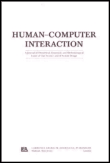
HUMAN-COMPUTER INTERACTION
Unleashing the Potential of Human-Computer InteractionHUMAN-COMPUTER INTERACTION is a premier academic journal published by Taylor & Francis Inc, dedicated to the interdisciplinary field of HCI, which explores the dynamic interactions between humans and computers. With its ISSN 0737-0024 and E-ISSN 1532-7051, the journal maintains a strong presence within the academic community and is recognized for its significant impact, holding a commendable impact factor that underscores its relevance. Ranked in the Q1 category for both Applied Psychology and Human-Computer Interaction, it occupies a critical position in Scopus rankings, listed as #15 in Applied Psychology and #11 in Computer Science, Human-Computer Interaction, placing it in the top 6% of relevant fields. Covering a broad spectrum of topics from usability studies to user experience design, the journal aims to facilitate innovative research and provide insights that bridge theoretical frameworks and practical applications. Published since 1985 and continuously evolving, HUMAN-COMPUTER INTERACTION remains an essential resource for researchers, professionals, and students eager to contribute to and benefit from advances in understanding how technology can effectively serve human needs.

CCF Transactions on Pervasive Computing and Interaction
Advancing the Future of Interactive ComputingCCF Transactions on Pervasive Computing and Interaction, published by SPRINGERNATURE, is a leading academic journal dedicated to advancing the field of pervasive computing and interaction. With an ISSN of 2524-521X and E-ISSN 2524-5228, this journal is well-regarded for its rigorous peer-reviewed research, featuring influential studies that explore the intersection of Artificial Intelligence, Computer Networks and Communications, Computer Science Applications, and Human-Computer Interaction. Recognized in the 2023 journal rankings, it holds a prestigious Q2 quartile classification across these domains, reflecting its impact and relevance in the academic community. Researchers and practitioners can greatly benefit from its contributions, showcasing innovative approaches and technologies that shape the future of interactive computing. Although currently not following an open-access model, the journal underscores its commitment to high-quality research dissemination, making it a vital resource for those interested in the evolving landscape of pervasive technologies and user-centric designs. For more information on submissions and access options, please refer to the official website.
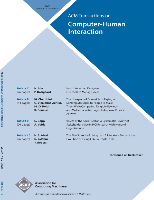
ACM Transactions on Computer-Human Interaction
Empowering Research that Shapes Tomorrow's InterfacesACM Transactions on Computer-Human Interaction (ISSN: 1073-0516; E-ISSN: 1557-7325) is a prestigious journal published by the Association for Computing Machinery, focusing on the dynamic and rapidly evolving field of Human-Computer Interaction (HCI). With an impressive 2023 impact factor reflecting its high-quality research output, it proudly holds a Q1 ranking in the HCI category on Scopus, positioning it among the top journals in the field. Established in 1994, the journal has been a vital resource for researchers and professionals alike, featuring innovative studies that explore the design, evaluation, and implementation of user interfaces and interactive systems. Its broad scope encompasses various aspects of HCI, including cognitive processes, user experience design, and the social implications of technology. As an essential read for anyone involved in HCI research and practice, the journal is a gateway to advancements that shape the future of human-technology interactions. The journal is accessible to readers globally, and it plays a pivotal role in disseminating knowledge that drives excellence in software design and user interface research.
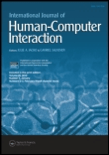
INTERNATIONAL JOURNAL OF HUMAN-COMPUTER INTERACTION
Elevating Human-Centric Design and ResearchINTERNATIONAL JOURNAL OF HUMAN-COMPUTER INTERACTION, published by Taylor & Francis Inc, stands at the forefront of research within the interdisciplinary fields of human-computer interaction, human factors, and ergonomics. Since its establishment, the journal has consistently contributed to advancing the understanding of the interactions between people and computers, making it a vital resource for researchers, professionals, and students alike. With an impressive impact factor reflecting its high citation rate, this journal is recognized as a Q1 publication in both Computer Science Applications and Human Factors and Ergonomics categories for 2023, showcasing its stature within the academic community. Additionally, it boasts a commendable ranking within the top percentiles in key areas on Scopus, ensuring that the research published here reaches broad scholarly audiences. Available in traditional subscription format, the journal covers seminal studies from 1989 to 2024, reflecting ongoing innovation in technology and its applications in everyday life, and thus serves as an essential platform for pioneering research that shapes the future of user experience.

International Journal of Mobile Human Computer Interaction
Exploring the nexus of human experience and mobile technology.International Journal of Mobile Human Computer Interaction (IJMHCI) is a leading scholarly publication dedicated to advancing the field of human-computer interaction in mobile environments. Established by IGI Global, this journal has served as a vital platform for researchers and professionals since its inception in 2009. With a focus on innovative designs, user experience, and the evolving landscape of mobile technology, IJMHCI plays a critical role in bridging theoretical research and practical applications. Though currently categorized in Q4 within the Human-Computer Interaction category for 2023, its consistent publication across the years reflects a commitment to fostering insightful discussions among academia and industry practitioners alike. The journal is indexed in Scopus, ranking #78 out of 145 in its field, highlighting its growing influence. While it does not currently offer open access options, its valuable contributions to mobile HCI research make it an essential resource for students and established researchers striving to explore the complexities of human interaction with mobile technologies.
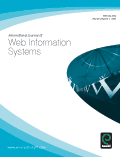
International Journal of Web Information Systems
Fostering collaboration in the world of information systems.The International Journal of Web Information Systems is a distinguished publication dedicated to advancing the field of web information systems, offering a platform for high-quality research and innovative practices. Published by EMERALD GROUP PUBLISHING LTD in the United Kingdom, this journal has established itself as a vital resource for researchers, practitioners, and academics from various disciplines, particularly in Computer Networks and Communications and Information Systems, as evidenced by its ranking in the 2023 quartile assessments (Q3) and Scopus rankings. With an H-index reflecting its impact within the academic community and a publication window spanning from 2005 to 2024, the journal is committed to fostering scholarly exchange and collaboration. While it currently does not have open access options, it provides valuable insights and breakthroughs that are essential for professionals and students navigating the ever-evolving digital landscape.
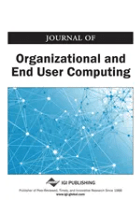
Journal of Organizational and End User Computing
Bridging Digital Interfaces with Organizational StrategiesThe Journal of Organizational and End User Computing, published by IGI Global, is a leading peer-reviewed outlet dedicated to exploring the intersection of organizational practices and user interfaces within the digital realm. With a robust ISSN of 1546-2234 and an E-ISSN of 1546-5012, the journal has established itself as a crucial resource for scholars and practitioners in the fields of Computer Science Applications, Human-Computer Interaction, and Strategy and Management. Recognized for its quality, the journal attained Q3 status in Computer Science Applications and Human-Computer Interaction, and Q2 status in Strategy and Management in 2023, reflecting its esteemed position in academic rankings. Operating from the heart of the United States, the journal has converged its focus from 2004 to 2024, making it a reliable source for cutting-edge research and industry trends. Although it does not offer open access, the Journal of Organizational and End User Computing remains an invaluable repository of knowledge, perfect for researchers, professionals, and students seeking to advance their understanding of organizational structures and user engagement in computing environments.
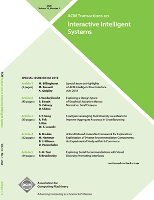
ACM Transactions on Interactive Intelligent Systems
Elevating the Standards of Human-Computer Synergy.ACM Transactions on Interactive Intelligent Systems is a distinguished journal published by the Association for Computing Machinery (ACM), specializing in the realms of Artificial Intelligence and Human-Computer Interaction. With an impactful presence in the academic community, it boasts a respectable Q2 quartile ranking in both fields as of 2023, highlighting its significant contributions to advancing interactive intelligent systems. The journal, identified by ISSN 2160-6455 and E-ISSN 2160-6463, encompasses a broad spectrum of research from theoretical advancements to practical implementations, offering invaluable insights for researchers, professionals, and students. The journal not only serves as a platform for innovative ideas and methodologies but also emphasizes the importance of interdisciplinary approaches in its publications. Positioned in the United States, at 1601 Broadway, 10th Floor, NEW YORK, NY 10019-7434, it stands out for its commitment to quality, rigor, and relevance within the computing and interactive systems sectors.

ACM Transactions on the Web
Empowering Knowledge in Web Research and DevelopmentACM Transactions on the Web is a highly regarded journal published by the Association for Computing Machinery (ACM), focusing on the vast and evolving field of web technologies and their applications. With an impact factor that places it in the Q2 quartile of the Computer Networks and Communications category for 2023, this journal ranks #154 out of 395 in its discipline, showcasing its significance in advancing research and knowledge in the domain. Since its inception in 2007 and continuing through 2024, the journal has been dedicated to publishing original research that contributes to all aspects of web-based systems, applications, and services. ACM Transactions on the Web provides an essential platform for scientists, engineers, and practitioners engaged in web research, offering insights into cutting-edge methodologies and emerging technologies. Readers will appreciate the depth and diversity of articles, which encompass both theoretical and applied research, as well as reviews and case studies. The journal's commitment to quality and rigor makes it a valuable resource for anyone invested in the future of web technologies.